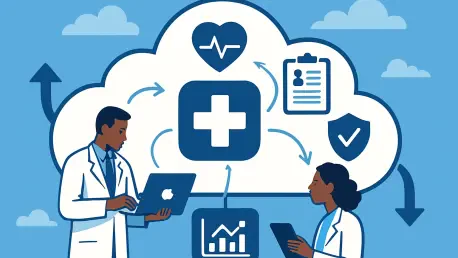The integration of cloud computing in healthcare is not merely a trend but a fundamental shift driving digital transformation. With an estimated compound annual growth rate (CAGR) of 16% by 2030, this technological advancement is reshaping the delivery and experience of healthcare services. Healthcare providers face new challenges and are adopting advanced technologies to enhance healthcare access, patient care, and operational efficiency. The digitalization of healthcare records, expansion of telemedicine, and implementation of remote monitoring solutions are pivotal elements driving this change.
The Rise of Digital Health Technologies
Electronic Health Records and Telemedicine
The skyrocketing adoption of cloud-based electronic health records (EHRs) underscores the healthcare industry’s pivot towards more agile and secure patient data management systems. These digital records are accessible from any authorized device, offering healthcare providers a comprehensive and up-to-date view of patient history, which expedites decision-making and enhances patient outcomes. Furthermore, the proliferation of telemedicine has shattered geographical barriers, allowing patients to receive care from specialists worldwide. By using cloud technology, teleconferencing, secure patient portals, and remote diagnostics, healthcare professionals can administer care to patients in rural or underserved areas, ensuring they receive timely consultations and treatments.
Reliable cloud solutions provide the necessary bandwidth and storage capabilities to host these services seamlessly, avoiding the high costs of in-house IT systems. This elevates the standard of care and encourages a patient-centered approach, focusing on the needs and preferences of individuals. Integrating EHRs with cloud technology contributes to a more personalized healthcare experience, aligning with patient-specific health requirements and preferences. This, combined with telemedicine, exemplifies how digital technologies are transforming traditional healthcare models, aligning with the evolving demands of modern healthcare delivery.
Remote Patient Monitoring and Personalized Care
The increased implementation of remote patient monitoring solutions, powered by cloud computing, offers a promising avenue for continuous health management outside conventional healthcare settings. These solutions include wearable devices and Internet of Things (IoT) applications, which collect vital health data from patients in real-time. This data is instantly uploaded to the cloud, where it is monitored and analyzed by healthcare professionals, ensuring timely interventions when abnormalities are detected. This continuous monitoring aids in proactive healthcare management, improving patient outcomes with prompt and effective interventions.
The advent of artificial intelligence (AI) and big data analytics within cloud platforms is refining personalized patient care further. By processing vast amounts of health data, AI algorithms identify patterns and predict outcomes, assisting healthcare providers in crafting individualized treatment plans. This customization fosters more effective treatments and mitigates unnecessary medical procedures. Advances in remote monitoring and personalized care demonstrate how cloud computing is central in transitioning healthcare into a more proactive, individualized approach, focusing on prevention rather than reaction.
Strategic Collaborations and Cloud Investments
Key Player Initiatives and Strategic Partnerships
Industry leaders such as Amazon Web Services (AWS) are at the forefront, actively fostering cloud adoption in healthcare through financial investments and strategic collaborations. AWS’s commitment reflects in initiatives like a $10 million grant in 2024 aimed at boosting data sharing and AI-driven healthcare solutions. This financial backing empowers healthcare providers to adopt more sophisticated cloud solutions, enabling advanced analytics and personalized treatments. This commitment extends further, with AWS investing in initiatives focused on health equity—dedicating funds to enhance healthcare access for traditionally underserved communities through cloud technology integration.
Moreover, collaborations play a significant role in expanding cloud computing in healthcare. Notable examples include GE Healthcare’s collaboration with AWS in 2024 to develop generative AI models for optimizing healthcare operations. This partnership leverages AWS’s robust cloud infrastructure to integrate advanced AI solutions, improving diagnostics and clinical decision-making processes. Strategic partnerships epitomize the industry’s collective push to harness cloud technology’s full potential, ultimately driving innovations that benefit both providers and patients through better resource allocation and patient engagement strategies.
Challenges in Transitioning and Infrastructural Integration
Transitioning from traditional systems to cloud-based solutions is not without challenges. The complexity, financial investment, and customization required for integrating new cloud systems can be daunting. Healthcare organizations face the arduous task of ensuring smooth data migration from legacy systems to new platforms without disrupting patient care or compromising data integrity. Additionally, healthcare workforce training is imperative to achieve proficiency in new systems, a process that can often lead to resistance and require substantial time and resources to implement effectively.
Another critical concern is the secure and reliable migration of vast amounts of sensitive patient data. Ensuring compliance with stringent healthcare data regulations and safeguarding patient confidentiality are paramount. Data breaches or mishandling during migration can have dire consequences, impairing patient trust and care quality. However, overcoming these challenges offers significant long-term benefits, enhancing operational efficiencies, data handling capabilities, and fostering innovation in the healthcare cloud computing sector. Successful transitions catalyze widespread cloud adoption, setting the stage for sustained growth and advancements in healthcare services.
The Competitive Landscape and Market Growth
Industry Leaders and Market Segmentation
Within the dynamic arena of healthcare cloud computing, leading companies are aggressively pursuing strategies to amplify their market influence. Major corporations such as Amazon Web Services, Microsoft, Google, and IBM are innovating relentlessly, developing cutting-edge products and expanding globally through well-strategized partnerships. These enterprises focus keenly on enhancing cloud adoption rates by delivering solutions that meet the growing demands of healthcare providers and consumers. Their efforts symbolize a combined commitment to transforming healthcare delivery through advanced technologies, ultimately aiming to improve patient care and streamline healthcare operations.
The global healthcare cloud computing market is segmented across various facets, predicting significant growth dimensions from 2025 to 2030. Market division includes product categories, deployment models, service models, and geographical regions, reflecting the multifaceted nature of cloud adoption in healthcare. Such comprehensive segmentation highlights how cloud solutions address differing needs across diverse healthcare settings, offering sufficient flexibility and scalability to adapt to individual requirements. As more healthcare providers recognize the strategic advantages of cloud computing, the trajectory of market growth and diversification remains poised for acceleration, revolutionizing healthcare environments globally and locally.
Future Prospects and Technological Advancements
The evolution of cloud computing in healthcare continues to unlock myriad opportunities, driving the industry towards more efficient, accessible, and equitable care. Future prospects include advancements in AI and machine learning capabilities within cloud platforms, offering even more potent diagnostic and treatment tools. These innovations will likely redefine predictive healthcare models, leading to better patient outcomes and streamlined healthcare processes. The marriage of cloud computing with emerging technologies will further facilitate integrated care delivery systems, fostering seamless collaboration between different healthcare entities.
The focus on enhancing healthcare access and managing population health predicates broader adoption of cloud technologies, particularly within underserved communities. Continued investment in cloud infrastructure ensures scalable, secure, and robust solutions that can withstand increasing data volumes and computational demands. The commitment to cloud solutions posits a transformative journey for healthcare providers and patients alike, offering room for more progressive, patient-centric healthcare models that prioritize quality, accessibility, and innovation.
Conclusion: Navigating the Future with Cloud Technology
The integration of cloud computing in healthcare signifies not just a trend but a crucial transformation leading digital change in the industry. Projected to achieve a compound annual growth rate of 16% by 2030, this technological breakthrough is fundamentally altering healthcare delivery and experience. Healthcare professionals face new challenges and are increasingly turning to cutting-edge technologies to improve accessibility, patient care, and operational efficiency. The shift includes the digitalization of healthcare records, which ensures more efficient data handling and sharing among healthcare providers. Furthermore, the expansion of telemedicine allows for increased access to medical care, especially in remote or underserved areas, providing patients with the convenience of consults from home. Implementing remote monitoring solutions further enhances patient care by enabling continuous tracking of patients’ health conditions, helping to prevent complications and reducing hospital readmissions. These elements are crucial in driving the ongoing evolution within the healthcare sector.









